Are we witnessing the early footsteps of a solar car future? With more and more developed and developing nations accepting the need for combating pollution and thus a shift in environmental policy, electric vehicles in general as well as solar-powered electric vehicles are on the rise.
In this article, we will explore the trendy topic of electric vehicles and examine the current status and future of solar in this field.
What are electric vehicles and solar electric vehicles?
An electric vehicle (EV) is a vehicle that can run on electricity. A truly electric vehicle will run only on electricity. While road vehicles will have batteries and plug-in charging, tracked vehicles like trains can remain continuously connected to power rails.
Power rails overhead can have a direct connection, while power can also be obtained via induction from rails buried underground. Electric cars are invariably powered by a rechargeable battery. In view of the limited capacity of available batteries, currently hybrid power systems are more popular.
A hybrid electric vehicle can run either on electricity or fossil fuel. They have a fossil fuel engine and a generator in addition to the electric motor. Hybrid systems also provide a fall-back in case the electric drive fails.
The solar electric vehicle is a class of electric vehicle whose primary source of energy is the sun.
Solar-powered vehicles or simply: solar vehicles that generate and store hydrogen for combustion could also become feasible in the future. But the word solar vehicle normally implies a solar PV electric vehicle.
Such vehicles will have to depend on large batteries for storage, although plug-in charging and fossil generation will provide reliability and longer ranges.
Development history of electric vehicles
The first technological step towards the creation of the EV was taken in 1827 at the hands of a priest named Ányos Jedlik when he built the first viable electric motor. The very next year he used it to power a tiny car.
Electric cars gradually improved and became popular, but when the internal combustion engine matured sufficiently, electric vehicles were replaced by fuel-powered vehicles because of the higher ranges provided by them.
Only railed electric vehicles, like trains, survived because they did not need any charge storage on board. However, now fast forward to the 21st century, and electrical vehicles are making a definite comeback.
Purely electric cars are not yet practical because of the limited range current storage technologies offer in one charge. Hence, hybrid power cars (gasoline plus battery) are more the norm.
Current examples are the Toyota Prius, Nissan Leaf, Ford Focus Electric, Tesla Model S, and Chevrolet Volt. Toyota cars are the leaders in the global EV market.
Electric vehicles: advantages
Many advantages are associated with the use of an electric car. These will also apply to solar vehicles with minor limitations, but let’s first see the general advantages of EVs:
- Independent from fuel: electric cars are driven by electricity which can be charged even at home, especially during the night, and during off-peak hours. Public charging stations are now coming up fast and will become ubiquitous like the gas stations
- Environmental-friendly: electric vehicles have little impact on the environment, except for the production and assembly of the parts during their manufacture and except for the generation of electricity for charging them
- Efficiency: gasoline cars are wasteful. The tank-to-wheel efficiency of EV can be up to three times that of gas vehicles. Well-to-wheel efficiency is not that different, but still better. Regenerative braking allows the kinetic energy of the car to be converted back to reusable energy, further improving the efficiency
- Savings: operating costs vary depending on the cost of electricity being purchased, but will be lower than gasoline. According to general motors claim, the GM Volt should cost “less than 2 cents per mile on electricity”, compared to 12 cents a mile on gas
- Government incentives: governments in many countries are offering incentives for the purchase of EVs in order to promote a cleaner environment. China for example is heavily promoting and supporting the use of EVs
- Popularity: EV’s are becoming more popular and a status symbol
- Safety: with no combustible fuels, electric vehicles become safer even in case of accidents. Even braking can be computer controlled and regenerative. The only concern is about the Lithium-ion battery which can explode in rare situations. Manufacturers are expected to adhere to UNECE Regulation 100 on EV safety
- Cost-effective: improvement in technology, greater production numbers, government incentives, and reduced operating costs, all work together to make the EV cost-effective over its life cycle
- Low maintenance: electric vehicles are very reliable and require much less maintenance than complex gasoline engines. Hence maintenance costs and downtime are also lower
- Reduced noise: electric cars are much quieter because the only moving part in the drive is the motor. However, the low noise has raised concerns as pedestrians with impaired sight may be at risk. Some artificial noise may be added at low speeds to address this issue
- Higher acceleration: for the same power, the electric car is lighter, has less inertia, and hence better acceleration. Tesla Model S claimed 0 to 100 km/h in 3 seconds
- Energy resilience: electricity will be available from a number of alternate sources
Limitations of electric vehicles
The main limitations of electrical vehicles are high initial cost and limited range between charges. However, these limitations of EV are being gradually overcome as technology advances, costs decrease and sales volumes increase.
A minor limitation though is the need for new measures for cabin heating. Solar vehicles, on the other hand, can derive power from the sun on the go, and can even store the excess power if available.
But they have to depend on stored energy when the sun is not available. Solar vehicles will need special streamlining measures to avoid aerodynamic friction due to solar panels.
In conventional vehicles, waste heat is used for cabin heating when required. An engine-driven air conditioning system allows for cooling during hot summer days.
Heating and defrosting in EVs will have to be mainly electrical but integrated with battery and motor temperature management. Possible approaches involve that battery and motor waste heat are used to provide part of the cabin heating. This will also prolong the battery life. A heat pump can be used for both heating and cooling as required. Cabin insulation is being improved in newer designs.
Power Sources
Electric motors
Although road EVs run on battery, a 3-phase ac motor is used for a higher power. DC to AC inverters are used for providing the AC. Gear trains for torque adjustment are not required in electric cars and this helps weight reduction and complexity.
Motors of over 100 KW are used. Tesla motors designs employ induction motors while Nissan Leaf has permanent magnet motors. Universal motors will permit the use of AC or DC.
Electromagnetic radiation
Concern has been expressed about the effect of electromagnetic radiation on electrical motors. The fears are not really substantiated. Further, motors can be shielded in a Faraday Cage.
Solar vehicles
Solar PV vehicles run primarily on energy from the sun. These are not common as passenger vehicles but are currently primarily for solar car racing competitions and as technology demonstration examples.
These are mostly fielded by universities. Solar cars may use high-end technology applicable in various diverse fields, like automobile, aerospace, alternate energy, and even the bicycle.
A number of parameters of performance including those of the solar power system must be simultaneously monitored. This can overload the driver. Wireless telemetry is almost always used to permit the support team to monitor all parameters in real-time.
Power acquisition – a solar array
By definition, the power should be from the sun, although for practical reasons it may be wiser to have an alternate charging ability to meet emergencies.
Photovoltaic arrays convert sunlight to electricity using hundreds of solar cells connected in various configurations to give power. Modules are mounted in various configurations. Horizontal mounting is the most permits collection most of the day and has the least wind resistance during the drive.
The horizontal array can also be integrated with the body, or be in the form of a separate canopy. The modules can be mounted with an adjustable tilt to allow a little adjustment of solar collection angles as the sun moves or the vehicle changes direction.
The array mounting design is always a compromise between power collection, wind resistance, cost, and vehicle stability during the drive. In the case of solar racing cars, the arrays will be integrated and mounted on all sides with as much streamlining as possible, and covered with a thin layer of Tedlar.
Power storage
In a typical solar car, the battery pack will allow a range of about 400km when fully charged at continuous speeds of about 100 Km per hour. Lithium-ion or nickel-cadmium batteries are generally used. The motors used are light and typically 2-3 horsepower (about 2 kW).
The body structure of solar cars
Body structure must be light, and fire-resistant. Solar car bodies will employ lightweight materials like glass fiber reinforced with carbon fiber as far as possible. The shape is specially streamlined in the case of racing cars in order to decrease wind resistance. For this reason, the modules are integrated, and further given a light overcoat of Tedlar.
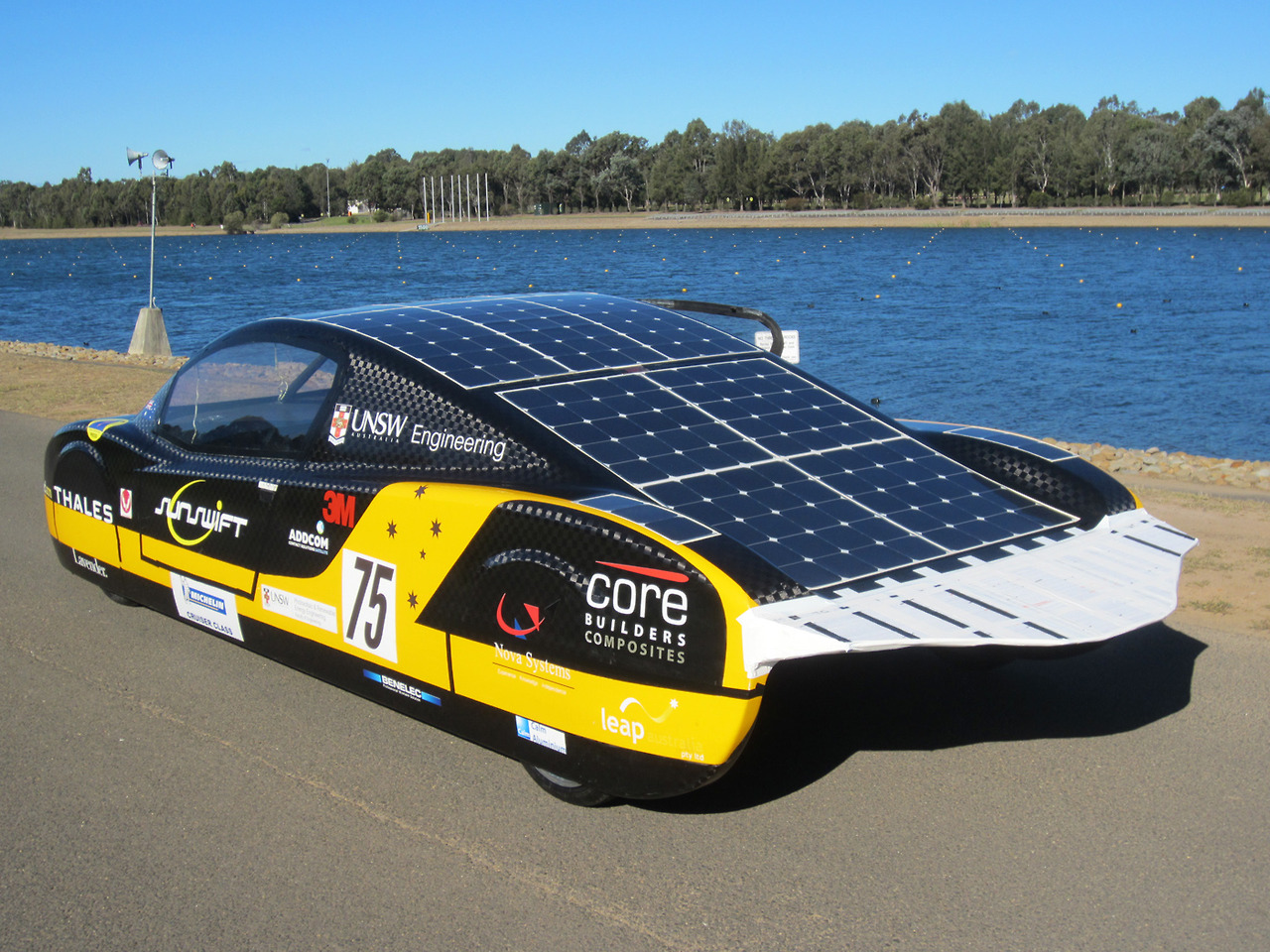 Solar car of the UNSW Solar Racing Team (Sunswift) (source: AustralianSolarQuotes.au)
Solar car of the UNSW Solar Racing Team (Sunswift) (source: AustralianSolarQuotes.au)Solar car races
Solar cars are still primarily used as technology demonstrators fielded mostly by university teams in various competitions. These competitions are a good way to promote student research and ingenuity in addition to healthy sports. Some of the major solar car races are:
The World Solar Challenge is held in Australia over a distance of 3000 km and teams are fielded from the entire world. The American Solar Challenge is mostly a university competition participated by students.
Then there is the Dell-Winston School Solar Car Challenge which is held annually but on alternate tracks every year. High school students participate in this competition sponsored by Dell.
Last but not least, the South African Solar Challenge is a bi-annual event spread over two weeks. Solar cars designed and engineered by the teams themselves race across the continent.

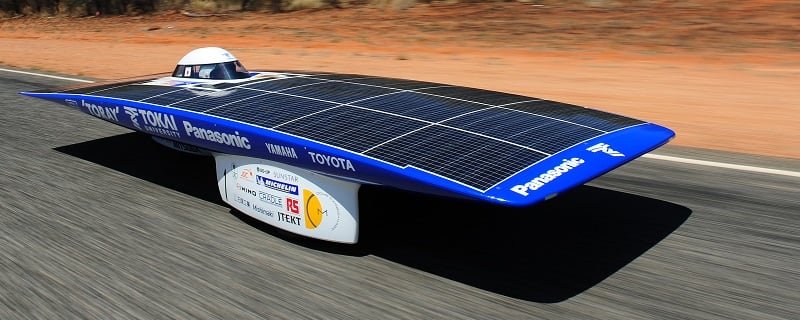
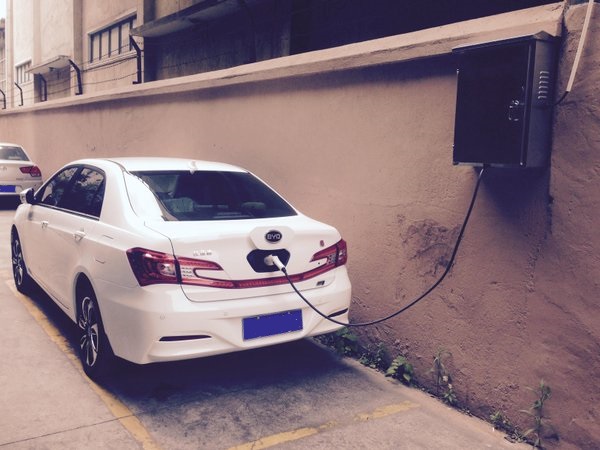
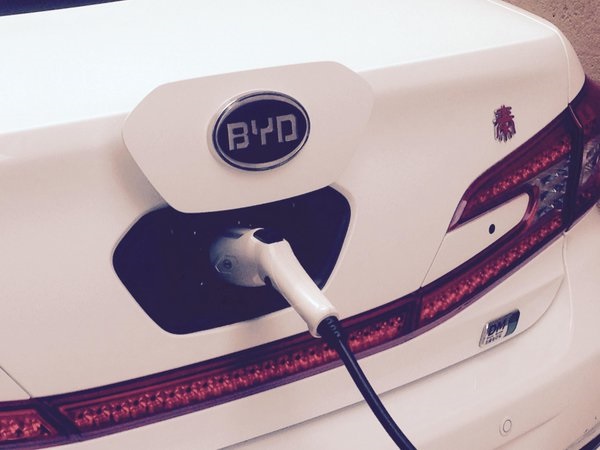
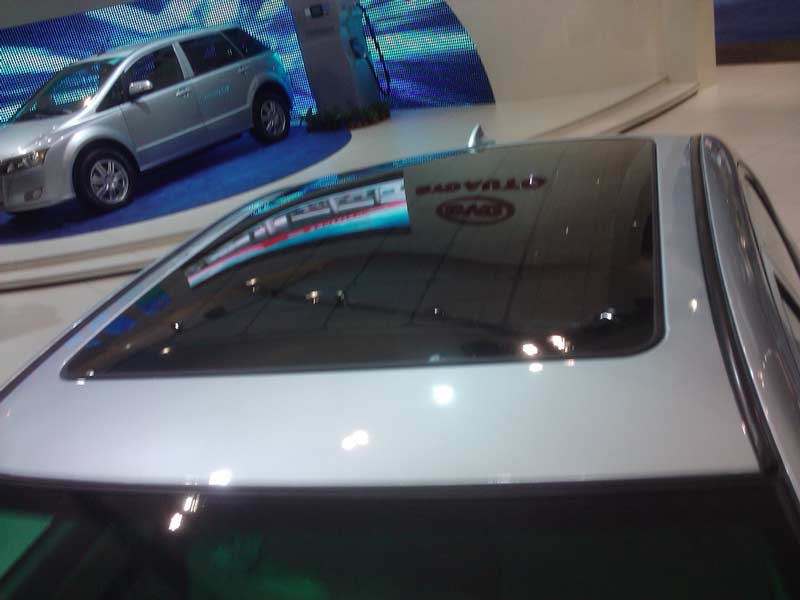

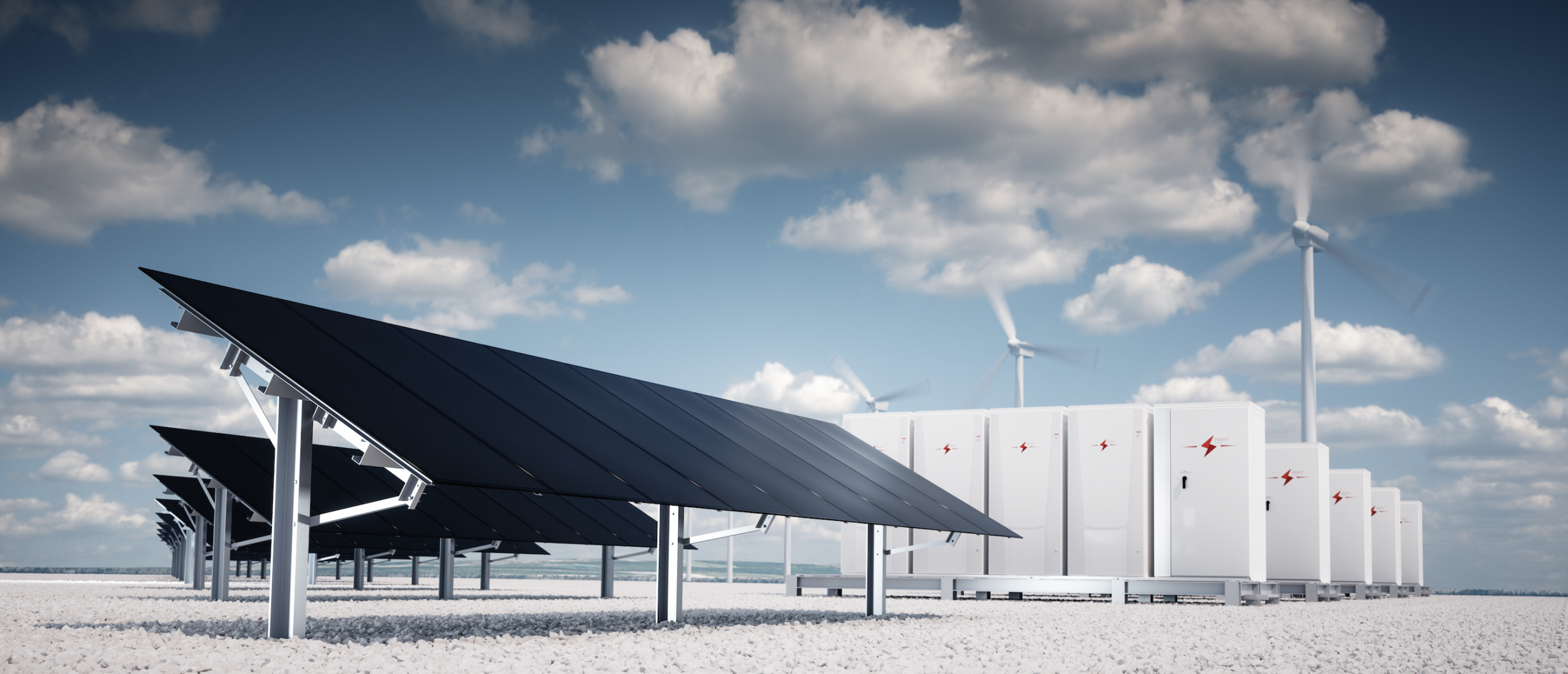
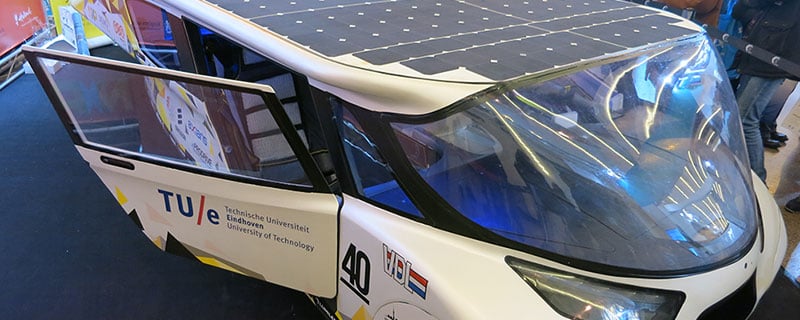
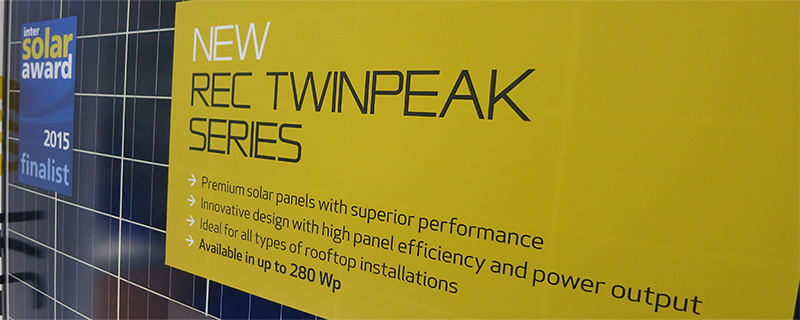
ShyamSundar Halder
on 26 Oct 2017